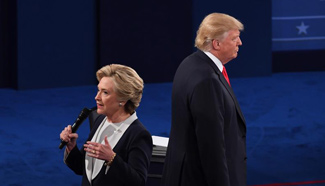BEIJING, Oct. 10 (Xinhua) -- The central parity rate of the Chinese yuan weakened to a six-year low against the U.S. dollar on Monday, but the People's Bank of China (PBOC), the central bank, voiced confidence in the currency's long-term stability.
The central parity rate weakened 230 basis points to 6.7008 against the dollar, according to the China Foreign Exchange Trade System (CFETS), the lowest level since September 2010. The dollar strengthened due to a sharp depreciation of the British pound and increased expectations of a U.S. interest rate hike.
Despite the decline against the dollar, the yuan strengthened against a basket of currencies, according to a commentary on the CFETS website, which is run by the PBOC.
"There is no basis for the yuan to depreciate in the long term," the commentary said, citing China's long-term current account surplus, abundant forex reserves, sound fiscal conditions and a healthy financial system.
It is normal for the yuan to fluctuate against the dollar and it will continue to do so, said the commentary.
The recent inclusion in the IMF Special Drawing Right (SDR) basket will help the yuan stay basically stable against other currencies "at a reasonable and balanced level" by increasing overseas holding of yuan assets, the commentary said.
The "Financial News," administered by the People's Bank of China, published an article on Monday predicting overall stability of the yuan despite short-term pressure from a strong dollar.
SDR inclusion is expected to increase the yuan's share in global forex trading to around 15 percent by 2020 from the current level of 5 percent and a growing trade surplus will help forex reserves and keep the currency stay largely stable.
China's forex reserves fell to 3.17 trillion U.S. dollars at the end of September, the third consecutive monthly fall. Han Huishi, a China Construction Bank analyst, blamed the drop on short-term factors, and noted that China might have sold some forex reserves to stabilize the yuan ahead of the SDR inclusion.
Purchases of foreign currency by Chinese residents ahead of the week-long national holiday that ended on Oct. 7 was another reason for the fall in reserves, Han said.
In September, the yuan was relatively steady against a basket of currencies. The yuan exchange rate composite index, which measures the yuan's strength relative to a basket of currencies including the U.S. dollar, euro and Japanese yen, weakened by 0.28 percent month on month to 94.07, according to CFETS data.
During the same period, the index that measures the yuan against the Bank for International Settlements currency basket weakened by 0.31 percent, while that against the SDR basket weakened by only 0.06 percent.
In China's spot foreign exchange market, the yuan is allowed to rise or fall by 2 percent from the central parity rate each trading day.
The central parity rate is based on a weighted average of prices offered by market makers before the opening of the interbank market each business day.










